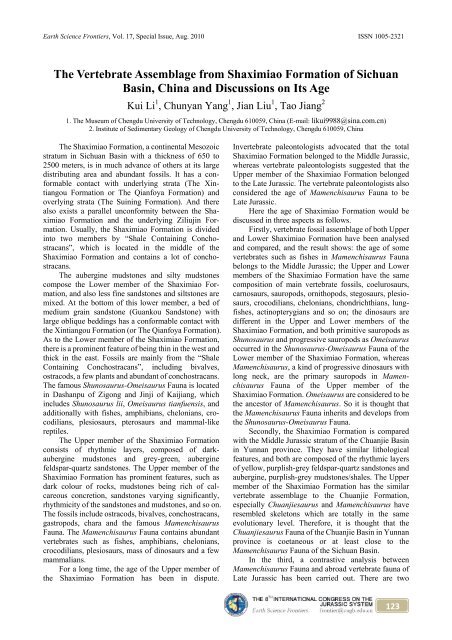in Jurassic and Cretaceous Stratigraphy
in Jurassic and Cretaceous Stratigraphy
in Jurassic and Cretaceous Stratigraphy
Create successful ePaper yourself
Turn your PDF publications into a flip-book with our unique Google optimized e-Paper software.
Earth Science Frontiers, Vol. 17, Special Issue, Aug. 2010 ISSN 1005-2321<br />
The Vertebrate Assemblage from Shaximiao Formation of Sichuan<br />
Bas<strong>in</strong>, Ch<strong>in</strong>a <strong>and</strong> Discussions on Its Age<br />
Kui Li 1 , Chunyan Yang 1 , Jian Liu 1 , Tao Jiang 2<br />
1. The Museum of Chengdu University of Technology, Chengdu 610059, Ch<strong>in</strong>a (E-mail: likui9988@s<strong>in</strong>a.com.cn)<br />
2. Institute of Sedimentary Geology of Chengdu University of Technology, Chengdu 610059, Ch<strong>in</strong>a<br />
The Shaximiao Formation, a cont<strong>in</strong>ental Mesozoic<br />
stratum <strong>in</strong> Sichuan Bas<strong>in</strong> with a thickness of 650 to<br />
2500 meters, is <strong>in</strong> much advance of others at its large<br />
distribut<strong>in</strong>g area <strong>and</strong> abundant fossils. It has a con-<br />
formable contact with underly<strong>in</strong>g strata (The X<strong>in</strong>-<br />
tiangou Formation or The Qianfoya Formation) <strong>and</strong><br />
overly<strong>in</strong>g strata (The Su<strong>in</strong><strong>in</strong>g Formation). And there<br />
also exists a parallel unconformity between the Sha-<br />
ximiao Formation <strong>and</strong> the underly<strong>in</strong>g Ziliuj<strong>in</strong> For-<br />
mation. Usually, the Shaximiao Formation is divided<br />
<strong>in</strong>to two members by “Shale Conta<strong>in</strong><strong>in</strong>g Concho-<br />
stracans”, which is located <strong>in</strong> the middle of the<br />
Shaximiao Formation <strong>and</strong> conta<strong>in</strong>s a lot of concho-<br />
stracans.<br />
The auberg<strong>in</strong>e mudstones <strong>and</strong> silty mudstones<br />
compose the Lower member of the Shaximiao For-<br />
mation, <strong>and</strong> also less f<strong>in</strong>e s<strong>and</strong>stones <strong>and</strong> siltstones are<br />
mixed. At the bottom of this lower member, a bed of<br />
medium gra<strong>in</strong> s<strong>and</strong>stone (Guankou S<strong>and</strong>stone) with<br />
large oblique bedd<strong>in</strong>gs has a conformable contact with<br />
the X<strong>in</strong>tiangou Formation (or The Qianfoya Formation).<br />
As to the Lower member of the Shaximiao Formation,<br />
there is a prom<strong>in</strong>ent feature of be<strong>in</strong>g th<strong>in</strong> <strong>in</strong> the west <strong>and</strong><br />
thick <strong>in</strong> the east. Fossils are ma<strong>in</strong>ly from the “Shale<br />
Conta<strong>in</strong><strong>in</strong>g Conchostracans”, <strong>in</strong>clud<strong>in</strong>g bivalves,<br />
ostracods, a few plants <strong>and</strong> abundant of conchostracans.<br />
The famous Shunosaurus-Omeisaurus Fauna is located<br />
<strong>in</strong> Dashanpu of Zigong <strong>and</strong> J<strong>in</strong>ji of Kaijiang, which<br />
<strong>in</strong>cludes Shunosaurus lii, Omeisaurus tianfuensis, <strong>and</strong><br />
additionally with fishes, amphibians, chelonians, cro-<br />
codilians, plesiosaurs, pterosaurs <strong>and</strong> mammal-like<br />
reptiles.<br />
The Upper member of the Shaximiao Formation<br />
consists of rhythmic layers, composed of dark-<br />
auberg<strong>in</strong>e mudstones <strong>and</strong> grey-green, auberg<strong>in</strong>e<br />
feldspar-quartz s<strong>and</strong>stones. The Upper member of the<br />
Shaximiao Formation has prom<strong>in</strong>ent features, such as<br />
dark colour of rocks, mudstones be<strong>in</strong>g rich of cal-<br />
careous concretion, s<strong>and</strong>stones vary<strong>in</strong>g significantly,<br />
rhythmicity of the s<strong>and</strong>stones <strong>and</strong> mudstones, <strong>and</strong> so on.<br />
The fossils <strong>in</strong>clude ostracods, bivalves, conchostracans,<br />
gastropods, chara <strong>and</strong> the famous Mamenchisaurus<br />
Fauna. The Mamenchisaurus Fauna conta<strong>in</strong>s abundant<br />
vertebrates such as fishes, amphibians, chelonians,<br />
crocodilians, plesiosaurs, mass of d<strong>in</strong>osaurs <strong>and</strong> a few<br />
mammalians.<br />
For a long time, the age of the Upper member of<br />
the Shaximiao Formation has been <strong>in</strong> dispute.<br />
Invertebrate paleontologists advocated that the total<br />
Shaximiao Formation belonged to the Middle <strong>Jurassic</strong>,<br />
whereas vertebrate paleontologists suggested that the<br />
Upper member of the Shaximiao Formation belonged<br />
to the Late <strong>Jurassic</strong>. The vertebrate paleontologists also<br />
considered the age of Mamenchisaurus Fauna to be<br />
Late <strong>Jurassic</strong>.<br />
Here the age of Shaximiao Formation would be<br />
discussed <strong>in</strong> three aspects as follows.<br />
Firstly, vertebrate fossil assemblage of both Upper<br />
<strong>and</strong> Lower Shaximiao Formation have been analysed<br />
<strong>and</strong> compared, <strong>and</strong> the result shows: the age of some<br />
vertebrates such as fishes <strong>in</strong> Mamenchisaurus Fauna<br />
belongs to the Middle <strong>Jurassic</strong>; the Upper <strong>and</strong> Lower<br />
members of the Shaximiao Formation have the same<br />
composition of ma<strong>in</strong> vertebrate fossils, coelurosaurs,<br />
carnosaurs, sauropods, ornithopods, stegosaurs, plesio-<br />
saurs, crocodilians, chelonians, chondrichthians, lung-<br />
fishes, act<strong>in</strong>opterygians <strong>and</strong> so on; the d<strong>in</strong>osaurs are<br />
different <strong>in</strong> the Upper <strong>and</strong> Lower members of the<br />
Shaximiao Formation, <strong>and</strong> both primitive sauropods as<br />
Shunosaurus <strong>and</strong> progressive sauropods as Omeisaurus<br />
occurred <strong>in</strong> the Shunosaurus-Omeisaurus Fauna of the<br />
Lower member of the Shaximiao Formation, whereas<br />
Mamenchisaurus, a k<strong>in</strong>d of progressive d<strong>in</strong>osaurs with<br />
long neck, are the primary sauropods <strong>in</strong> Mamen-<br />
chisaurus Fauna of the Upper member of the<br />
Shaximiao Formation. Omeisaurus are considered to be<br />
the ancestor of Mamenchisaurus. So it is thought that<br />
the Mamenchisaurus Fauna <strong>in</strong>herits <strong>and</strong> develops from<br />
the Shunosaurus-Omeisaurus Fauna.<br />
Secondly, the Shaximiao Formation is compared<br />
with the Middle <strong>Jurassic</strong> stratum of the Chuanjie Bas<strong>in</strong><br />
<strong>in</strong> Yunnan prov<strong>in</strong>ce. They have similar lithological<br />
features, <strong>and</strong> both are composed of the rhythmic layers<br />
of yellow, purplish-grey feldspar-quartz s<strong>and</strong>stones <strong>and</strong><br />
auberg<strong>in</strong>e, purplish-grey mudstones/shales. The Upper<br />
member of the Shaximiao Formation has the similar<br />
vertebrate assemblage to the Chuanjie Formation,<br />
especially Chuanjiesaurus <strong>and</strong> Mamenchisaurus have<br />
resembled skeletons which are totally <strong>in</strong> the same<br />
evolutionary level. Therefore, it is thought that the<br />
Chuanjiesaurus Fauna of the Chuanjie Bas<strong>in</strong> <strong>in</strong> Yunnan<br />
prov<strong>in</strong>ce is coetaneous or at least close to the<br />
Mamenchisaurus Fauna of the Sichuan Bas<strong>in</strong>.<br />
In the third, a contrastive analysis between<br />
Mamenchisaurus Fauna <strong>and</strong> abroad vertebrate fauna of<br />
Late <strong>Jurassic</strong> has been carried out. There are two<br />
123

















